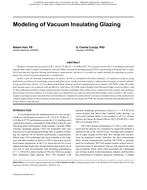Description
Windows with thermal resistance of R=10 h·ft² x °F/Btu (U=0.10 Btu/h·ft² x °F) or greater across theU.S. building stock could significantly reduce energy consumption (Arasteh 2006).Vacuum insulating glazing (VIG) is a promising technology that is capable of meeting the rigorous thermal performance requirements, but there is currently no simple method of evaluating its performance for research and development or certification.
In this work, the thermal transmittance (U-factor) of VIG is calculated with three methods: (1) analytical analysis using published correlations for modeling vacuum and pillar array conduction heat transfer; radiation heat transfer is solved explicitly using parallel plate theory; (2) two-dimensional finite element method computational heat transfer (2D FEM) where the pillar and vacuum space are replaced with an effective solid since 2D FEM cannot handle point thermal bridges such as pillars; and 3) three-dimensional finite volume numerical heat transfer modeling where pillar array conduction heat transfer and radiation heat transfer between surfaces in vacuum space are modeled to account for point thermal bridges such as pillars. The centerof- glass and edge-of-glass models from each method are compared to demonstrate a strong correlation between the methods and confirm applicability of representing vacuum space and pillar arrays using 2D FEM, the standard method of modeling and certifying windows and glazing.
Presented at Thermal Performance of Exterior Envelopes of Whole Buildings XII, December 2013
Citation: Thermal Performance of Exterior Envelopes of Whole Buildings XII
Product Details
- Published:
- 2013
- Number of Pages:
- 7
- File Size:
- 1 file , 1.3 MB
- Product Code(s):
- D-BldConf13-39




